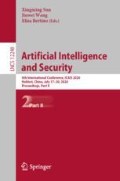Abstract
Due to the huge amount of data, network in real world is expanding rapidly. The structure of network is so complicate that a handy tool for analyzing is in desperate need. Link prediction provides forecast about entity interactions. A large range of areas can gain useful insights applying the prediction result. It can also help us understand the evolutionary mechanism of complex networks theoretically. This paper is aimed at promoting the performance of link prediction. We worked on two aspects to meet this end. Firstly, the weight and timestamp information were included in the data we referred to. We brought up the assumption of time attenuation effect. Secondly, we modified the PA index by dividing the links around targeted node pairs into different types. Instead of just focusing on the degree of two targeted nodes, links of various types weighs differently on the final prediction result. We conducted experiments on four real world datasets. The AUC using PA index considering link types was improved indeed.
Access this chapter
Tax calculation will be finalised at checkout
Purchases are for personal use only
References
Anil, A., et al.: Link prediction using social network analysis over heterogeneous terrorist network. In: 2015 IEEE International Conference on Smart City/SocialCom/SustainCom (SmartCity), pp. 267–272. IEEE (2015)
Fang, L., Fang, H., Tian, Y., Yang, T., Zhao, J.: The alliance relationship analysis of international terrorist organizations with link prediction. Phys. A 482, 573–584 (2017)
Yu, H., et al.: High-quality binary protein interaction map of the yeast interactome network. Science 322(5898), 104–110 (2008)
Xie, F., Chen, Z., Shang, J., Feng, X., Li, J.: A link prediction approach for item recommendation with complex number. Knowl. Based Syst. 81, 148–158 (2015)
Ma, C., Zhou, T., Zhang, H.F.: Playing the role of weak clique property in link prediction: a friend recommendation model. Sci. Rep. 6, 30098 (2016)
Zhang, P., Qiu, D., Zeng, A., Xiao, J.: A comprehensive comparison of network similarities for link prediction and spurious link elimination. Phys. A 500, 97–105 (2018)
Kumar, R., Novak, J., Tomkins, A.: Structure and evolution of online social networks. In: Yu, P., Han, J., Faloutsos, C. (eds.) Link Mining: Models, Algorithms, and Applications, pp. 337–357. Springer, New York (2010). https://doi.org/10.1007/978-1-4419-6515-8_13
Zhu, J., Hong, J., Hughes, J.G.: Using Markov models for web site link prediction. In: Proceedings of the uhirteenth ACM Conference on Hypertext and Hypermedia, pp. 169–170. ACM (2002)
Soundarajan, S., Hopcroft, J.E.: Use of supervised learning to predict directionality of links in a network. In: Zhou, S., Zhang, S., Karypis, G. (eds.) ADMA 2012. LNCS (LNAI), vol. 7713, pp. 395–406. Springer, Heidelberg (2012). https://doi.org/10.1007/978-3-642-35527-1_33
Sarukkai, R.R.: Link prediction and path analysis using Markov chains. Comput. Netw. 33(1–6), 377–386 (2000)
Pavlov, M., Ichise, R.: Finding experts by link prediction in co-authorship networks. FEWS 290, 42–55 (2007)
Newman, M.E.: Clustering and preferential attachment in growing networks. Phys. Rev. E 64(2), 025102 (2001)
Sørensen, T.J.: A method of establishing groups of equal amplitude in plant sociology based on similarity of species content and its application to analyses of the vegetation on Danish commons. Munksgaard, I kommission hos E (1948)
Jaccard, P.: Étude comparative de la distribution florale dans une portion des alpes et des jura. Bull. Soc. Vaudoise Sci. Nat. 37, 547–579 (1901)
Lü, L., Jin, C.H., Zhou, T.: Similarity index based on local paths for link prediction of complex networks. Phys. Rev. E 80(4), 046122 (2009)
Liu, W., Lü, L.: Link prediction based on local random walk. EPL (Europhysics Letters) 89(5), 58007 (2010)
Fernandez, P., et al.: Improving the vector auto regression technique for time-series link prediction by using support vector machine. In: MATEC Web of Conferences. vol. 56, p. 01008. EDP Sciences (2016)
Li, J.C., Zhao, D.L., Ge, B.F., Yang, K.W., Chen, Y.W.: A link prediction method for heterogeneous networks based on BP neural network. Phys. A 495, 1–17 (2018)
Xiao, Y., Li, X., Wang, H., Xu, M., Liu, Y.: 3-HBP: a three-level hidden bayesian link prediction model in social networks. IEEE Trans. Comput. Soc. Syst. 5(2), 430–443 (2018)
Bütün, E., Kaya, M.: A pattern based supervised link prediction in directed complex networks. Phys. A 525, 1136–1145 (2019)
Munasinghe, L., Ichise, R.: Time score: a new feature for link prediction in social networks. IEICE Trans. Inf. Syst. 95(3), 821–828 (2012)
Özcan, A., Öğüdücü, Ş.G.: Multivariate temporal link prediction in evolving social networks. In: 2015 IEEE/ACIS 14th International Conference on Computer and Information Science (ICIS), pp. 185–190. IEEE (2015)
Rossi, R.A., Ahmed, N.K.: The network data repository with interactive graph analytics and visualization. In: AAAI (2015). http://networkrepository.com
Kunegis, J.: KONECT - The Koblenz Network Collection. In: Proceedings of the International Conference on World Wide Web Companion, pp. 1343–1350 (2013). http://userpages.uni-koblenz.de/kunegis/paper/kunegis-koblenz-network-collection.pdf
Paranjape, A., Benson, A.R., Leskovec, J.: Motifs in temporal networks. In: Proceedings of the Tenth ACM International Conference on Web Search and Data Mining, pp. 601–610. ACM (2017)
Acknowledgement
This work is supported by National Natural Science Foundation of China (Grant No. 61871046).
Author information
Authors and Affiliations
Corresponding author
Editor information
Editors and Affiliations
Rights and permissions
Copyright information
© 2020 Springer Nature Switzerland AG
About this paper
Cite this paper
Zhang, X., Wang, X., Zhang, L. (2020). Link Prediction Based on Modified Preferential Attachment for Weighted and Temporal Networks. In: Sun, X., Wang, J., Bertino, E. (eds) Artificial Intelligence and Security. ICAIS 2020. Lecture Notes in Computer Science(), vol 12240. Springer, Cham. https://doi.org/10.1007/978-3-030-57881-7_71
Download citation
DOI: https://doi.org/10.1007/978-3-030-57881-7_71
Published:
Publisher Name: Springer, Cham
Print ISBN: 978-3-030-57880-0
Online ISBN: 978-3-030-57881-7
eBook Packages: Computer ScienceComputer Science (R0)

